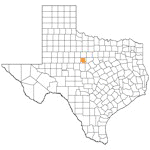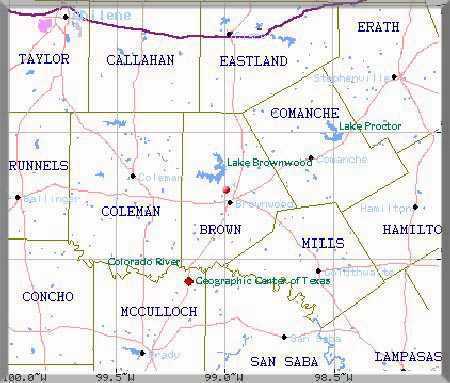
Brown County and
Callahan County


The William C. Sparks family moved to Brown county in 1870. His brother Martin Sparks moved his family to Callahan also, and the family began raising stock. Many years later, William C. Sparks' oldest son, Samuel Nathan Sparks wrote a letter describing life in Brown county, Texas. By the time the census of 1880 was taken, Callahan county had been organized and the Sparks family was enumerated in Callahan County, Texas instead of Brown.
 Brownwood
Texas, 1880 "Trade Days".
Brownwood
Texas, 1880 "Trade Days".
Click Picture to enlarge.
BROWN COUNTY was formed on the western frontier in 1856
from Comanche and Travis counties and organized in 1858, with Brownwood
designated as the county seat. In 1860 the United States census found 244
people living in the county, none of them slaveholders. The county developed
slowly between its founding and the 1870s, primarily because conditions were not
secure for settlement until the late 1870s or early 1880s, as settlers were
harassed by Indians and white predators for twenty years after the county was
formed. The original settlers had to resist Comanches who entered the region
from the north at Mercer's Gap or from the west along Pecan Bayou, near Elkins.
The Comanches, like other plains Indians were mounted warriors and splendid
buffalo hunters. White desperados caused problems too; in 1875 the Fort
Worth-Brownwood stage was robbed five times in two months. Much of the criminal
activity during the 1870s was attributed to John Wesley Hardin's gang; in 1874
Brown County citizens were among those who lynched suspected gang members at
Comanche, and Hardin himself was forced to flee.
Though increasing numbers of farmers moved into the area in the 1870s, 1880s,
and 1890s, the county's economy was dominated by cattle ranching throughout most
of the nineteenth century. The number of cattle in the county rose from 2,070 in
1860 to 40,000 in 1880 and remained at about the same level until 1900. County
ranchers joined the main cattle trail to Abilene and Dodge City in north Coleman
County and fought with local farmers attempting to fence off their lands. Strife
between ranchers and farmers over the fencing of open range raged for several
years until 1886, when the Texas Rangers killed two fence cutters (see also
fence cutting). Meanwhile, the number of farms in the area increased steadily,
rising from only twenty-two in 1870 to 1,206 in 1880 and 1,396 in 1890.
![]()
CALLAHAN COUNTY, located just east of Abilene, is bounded on the east by Eastland County, and on the south by Brown and Coleman counties. Until the 1870s the county was dominated by Comanche Indians and because of the threat of Comanche attack, little permanent settlement took place in the area. In 1877 the residents, more than 150 strong, signed a petition requesting the organization of Callahan County. At the election of July 3, 1877, Callahan City became the first county seat. Shortly after that, Belle Plain was voted in as the new county seat. After the railroad bypassed Belle Plain, the county seat moved to Baird in 1883, and is the county seat today.
During the early 1870s a number of settlers arrived. Most were ranchers, drawn to the area by abundant grazing land. In 1873 John Hittson established the headquarters of his Three Circle Ranch in Callahan County, and in 1874 Jasper McCoy established a ranch on Pecan Bayou. Other early settlers included the Merchant brothers and Dr. J. D. Windham, a physician, who also started a ranch operated by his sons in the southwestern part of the county. Despite the growing population, the threat of attack from hostile Comanches continued during the early 1870s. In 1874 United States troops under Col. Ranald S. Mackenzie defeated the Comanches at Palo Duro Canyon, and the same year Company E of the Frontier Battalion of the Texas Rangers, under the command of William J. Maltby, was sent to the area to drive the remaining Indians away. With the danger of Indian attacks over, large numbers of settlers began moving in. The construction of the railroad also opened the way for numerous new settlers. During the 1870s and 1880s several communities formed, including Cottonwood, Atwell, Cross Plains, Caddo Peak, Eagle Cove, and Eula. More settlers continued to arrive during the 1890s.
During the mid-1870s Callahan County became a transit area for cattlemen driving their herds to Kansas. On the way to Dodge City the Western Trail ran up the Pecan Bayou valley, passed near Belle Plain, and extended northward by way of the Bar-be-cue Ranch, just east of the site of present-day Baird. The Jacksboro Echo of July 21, 1876, estimated that some 73,000 cattle were driven up the trail in the first part of that year alone, and by 1880 the annual figure surpassed 260,000. The drives ended in the mid-1880s with the coming of the railroads, but they played an important role in drawing settlers to the area.
During the 1880s extensive farming was introduced. Settlers from East Texas began farming in the area around Cottonwood in the mid-1880s, raising cotton, oats, and various varieties of fruit. A severe drought in 1886-87 ruined crops and caused some to wonder if the region was suited to agriculture, but by the late 1880s the farming economy had recovered and was rapidly expanding. Between 1880 and 1890 the number of farms in the county grew from 346 to 518. Despite the impressive growth of agriculture, however, ranching continued to form the mainstay of the economy. The total number of cattle in the county during the period from 1890 and 1930 ranged between 25,000 and 35,000. Most were beef cattle. Some ranchers tried their hands at raising sheep in the 1880s and 1890s, but by the turn of the century most ranchers had sold their flocks.
BIBLIOGRAPHY: Thomas Robert Havins, Something about Brown: A History of Brown County, Texas (Brownwood, Texas: Banner Printing, 1958). Tevis Clyde Smith, Frontier's Generation (Brownwood, Texas, 1931; 2d ed. 1980). James C. White, The Promised Land: A History of Brown County (Brownwood, Texas: Brownwood Banner, 1941). Mrs. L. L. Blackburn, "Early Settlers and Settlements of Callahan County," West Texas Historical Association Year Book 23 (1947). Callahan County Historical Commission, I Remember Callahan: History of Callahan County, Texas (Dallas: Taylor, 1986). Brutus Clay Chrisman, Early Days in Callahan County (Abilene, Texas: Abilene Printing and Stationery, 1966). Fane Downs et al., Inventory of County Records, Callahan County Courthouse, Baird, Texas (Denton: Texas County Records Project, North Texas State University, 1977). Thomas Robert Havins, Belle Plain, Texas: Ghost Town in Callahan (Brownwood, Texas: Brown Press, 1972). S. E. Settle, "Early Days in Callahan County," West Texas Historical Association Year Book 12 (1936). Vertical Files, Callahan County Library and Museum, Baird, Texas. Jimmy West, "Indian Episodes of Callahan County," West Texas Historical Association Year Book 23 (1947).